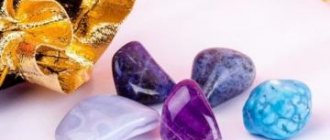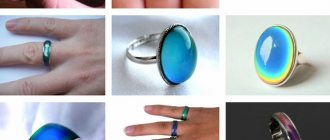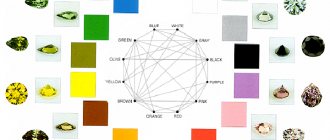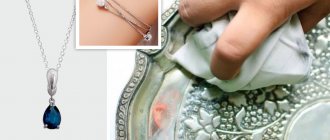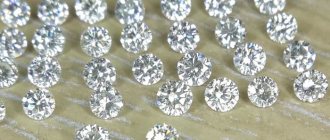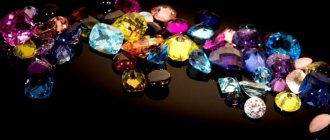Natural minerals are a symbol of strength and natural reliability. Their formation took hundreds and thousands of years, so such crystals can be called real long-livers. Color changing stone is a popular concept that combines precious and semi-precious gemstones with the alexandrite effect.
Such specimens are often called chameleons due to their changeable hue. In this article we will analyze the main types of minerals with this effect and who are suitable for chameleon stones according to their zodiac sign. The rules of care will allow you to preserve the beauty of your jewelry for a long time.
Why do stones change color?
The natural ability of crystals to change color can be called by different names:
- Pleochroism. The mineral changes color when light rays are reflected at different angles. That is, with a slight turn or change of point of view, the shade of the gem changes.
- Alexandrite effect. Implies changes in the color of crystals depending on lighting (daylight, artificial). This effect is also called color reverse. Jewelers use a similar concept when they want to indicate the depth of changes in color (the higher the percentage, the higher the price of such an item).
Note! In everyday communication, all such stones are called “chameleons”. The listed properties can only be found in natural crystals.
Reasons that affect the change in color of the stone:
- Physical. Any natural crystal is a unique combination of chemical elements. One or two basic components form the basis of the stone; the shade and other external characteristics depend on the impurities. Under the influence of humidity, temperature and lighting, special reactions occur between the chemical elements inside the natural crystal, which affects the shade. Radiation and other radiation and viewing angle also play a role.
- Magical. Astrologers and psychics are of the opinion that gemstones change their color when worn depending on the mood of the owner, general health, possible happy events and troubles in the near future. Outside influences also matter - the evil eye, black magic.
There are 2 groups of minerals based on their physical characteristics: the first - stones change color under different lighting (alexandrite, sultanite, tourmaline, amethyst), the second - minerals that change color depending on the increase/decrease in temperature (amethyst, aquamarine).
origin of name
Opals were first found in India, Central Europe and Latin America. Today, 90% of these stones are mined in Australia. The modern name of the stone comes from the word “upalah”, which means “stone” in Sanskrit. The Greek word "opallios" and the Latin "opalus" have the same meaning.
In the myths and legends of various peoples of the world there are stories telling about the origin of unique stones. Among them are the following:
- Indian mythology tells that once the goddess of love Kama was running away from the men who were pursuing her. It fell to the ground and crumbled into many beautiful stones, shimmering in a range of colors.
- The ancient Greeks believed that precious rainbow stones came from the tears of Zeus the Thunderer. Having defeated his father and the other Titans, the supreme Greek god shed tears of joy. When they fell to the ground, they turned into beautiful opals.
- The indigenous peoples of Australia have a legend about a god who created the world. He descended to earth to share his knowledge with his creatures. The creator's pure power was so powerful that gems with a rainbow effect appeared where he passed.
- In Norse mythology, the rainbow stone had sinister origins. The Vikings believed that opal was created by the god Volund from the eyes of babies. Therefore, it was considered an accumulator of dark energy, as well as a beacon for the forces of evil and various misfortunes. From the northern regions of Europe, this myth spread throughout all medieval countries.
Chameleon stones
Alexandrite
It is the main precious crystal that changes color. Its name is of imperial origin - the mineral was named in honor of the ruler Alexander II. The qualities of a chameleon in this case are due to the unique appearance of the crystal lattice and the presence of iron, titanium and chromium molecules in the composition. From the visible spectrum, such elements perceive only red and green light waves.
In the morning and daytime (with a lot of sun and ultraviolet rays), chromium plays a big role. The hue changes from soft purple to green-blue.
After sunset, infrared radiation predominates, which exhibits the properties of iron. The crystal colors in a crimson range: from crimson to dark red. When using various light filters, alexandrite changes its color to yellow-orange.
Note! The ability of a crystal to change shade under different lighting conditions is recognized as a standard. For this reason, such properties are called the “Alexandrite effect,” regardless of the mineral group of a particular stone.
Alexandrite is a mystery stone, it seems to absorb rays of light, becoming either greenish-blue or reddish-violet...
Published by Jewelry_Gems&Gold Sunday, September 30, 2018
Agate
The crystal belongs to the semi-precious group. It is able to change shade depending on the current state of health of the owner, mood and life circumstances. Agate is also known for its outstanding ability to detect deadly poisons: if something poisonous approaches the owner of the mineral, the stone sharply changes its color.
There is a known case of an agate jewelry that belonged to the famous theosophist Helena Blavatsky. This person was one of the key ones in the scientific community of the 19th century. The lady wore the agate ring as a decoration for a long time, and before leaving for the East she gave it to her sister. After some time, the stone turned completely black. Later it became known that this happened at the time of the death of the owner, thousands of kilometers from home.
Sultanite
Turkish stone is a real treasure of its country and a favorite of the sultans. A mineral can change its own shade under the influence of several factors:
- Amount of light. In low light outdoors or indoors, the crystal looks green, and in bright sunlight it becomes yellow-golden with cognac highlights. In terms of brightness and combination of shades, Turkish stones are more attractive than alexandrite.
- Impurities. The final color of each mineral is determined by impurities, the percentage of additional elements in the composition.
- Frame. This stone can only be set in platinum or high-grade gold - in a simple frame it quickly fades and becomes more cloudy.
Note! Sultanites are mined only in Turkey.
Amethyst
This mineral is a type of natural quartz. The chameleon effect is due to its special composition: inclusions of iron, aluminum and manganese.
Be sure to see: Properties and effects of black jade
The crystal changes under the influence of 2 factors.
- Lighting. If the oil is in natural light, the stone looks dull and noticeably fades (“daytime” amethysts). “Evening” stones, on the contrary, acquire mysterious shimmers and pronounced shine.
- Temperature conditions. When heated, the crystals become more transparent and lose color saturation. In this case, the purple tint may change to yellow or green. Similar color changes can be noticed upon contact with human skin.
The shimmer in this mineral includes a wide range of shades - from soft blue to dark purple.
Tourmaline
The mineral belongs to the semi-precious category; it is distinguished by inclusions of aluminum and boron compounds. Almost all varieties of tourmaline can boast a chameleon effect.
Under artificial light, the stone appears brown with hints of green and red, and under natural light it turns light pink. For magical recharging and bright shine, this stone needs bright sun.
Topaz
Stones of yellow, blue and pink colors effectively change shades. The stone retains its appearance in any light, but the color saturation may change with prolonged exposure to the sun. In this case, yellow crystals acquire a red tint, and blue and pink crystals become completely discolored.
Opal
Some gems are distinguished by a unique optical effect: light reflections of different colors of the rainbow are noticeable on their surface. This phenomenon is called opalescence.
Attention! Opals of Mexican origin have the most spectacular reflections. The play of shades on the surface of such a crystal resembles a living flame of fire.
The shade of opals can change with sharp fluctuations in air humidity (the approach of a thunderstorm or contact with a source of water). In this case, blue minerals become orange, and red ones acquire a yellow tint.
Moon rock
A stone that changes its hue depending on the phases of the moon. During the new moon, the mineral becomes milky white with minimal shine and shimmer, and closer to the new moon it acquires pronounced transparency.
This phenomenon remains unsolved in the scientific community. Magicians associate with it the great sensitivity of moonstone to all earthly processes. An unexpected change in shade may indicate future danger to the owner.
Aquamarine
A fairly valuable variety of natural beryl, which has a blue-green color. The mineral is capable of gradually changing color as the physical conditions and mood of the owner change.
The smooth rotation of the mineral allows you to see a slight silveriness, which is noticeable from the depths of the stone. When heated, “clumps” of paint and areas of uneven color can be found in the base of the mineral. Exposing the stone to the sun for a long time can cause it to turn yellow and have an earthy tint. When X-rayed, aquamarine appears bright green with small spots.
The mineral is sensitive to the owner’s well-being and the weather. The predominance of a green tint will indicate an imminent storm or the owner’s depressed mood. Cloudiness of the stone indicates possible troubles from other people.
Opal is a stone of different colors, from milky white to black, but with a constant inner rainbow glow.
As a mascot... Posted by Drasopus Thursday, March 23, 2021
Pyrope
It is a special, “ruby” variety of garnet. The color of the stone is provided by compounds of natural manganese, chromium and iron ore. The ratio of such elements in a particular case provides one or another shade. The range of colors is quite wide: from rich red to green and purple.
The stone has earned the name of an energy “barometer”. Upon contact with a strong-willed person who has powerful energy, the stone turns blood red. The lethargy of the owner can make such a mineral dull and inexpressive in color.
The changes in color will be greatest in Madagascar garnets. They can change up to 10 shades per day, which is why they are called “mood crystals.” When approaching equatorial latitudes, the natural play of light in such a stone intensifies.
Note! The listed stones look good as decorations and small talismans.
Change colors with temperature changes
Many minerals change color when heated. Most often, they simply become paler, even colorless, and even crack; however, for example, citrine only acquires a more saturated, bright yellow hue. The effect of temperature changes on the tone of the gem is presented in the table:
| Name | Heating effect |
| Aquamarine | Yellow tones go away |
| Amethyst | Transitions from purple to yellow, sometimes with a gray tint |
| Beryl | Goes from yellow to dark green |
| Turquoise | Turns into a black-brown mass |
| Garnet (Czech) | Blushes |
| Pearl | Loses its shine |
| Smoky quartz | Lightens or turns into a yellow-green, golden version |
| Coral | Loses color and shine when slightly heated |
| Kunzite | The rich shade becomes light, clear and pink |
| Rauchtopaz | Loses color and looks like citrine |
| Ruby | Brown shades and thin needle-like inclusions are removed |
| Sapphire (blue) | With weak exposure it turns pale, then becomes gray and completely opaque |
| Cornelian | Enhance Primary Color |
| Tanzanite | Loses the dirty brown tone, becomes pure purple or blue |
| Eye of the Tiger | Turns red and yellow |
| Topaz | Loses color. The Brazilian variety becomes deep red instead of pink. |
| Tourmaline | A rich blue or blue-green stone becomes a pure dark green. Salmon and cognac options turn into a beautiful pink. |
| Amber | Becomes a little paler, loses excess bubbles, and beautiful patterns appear |
The color of the stones and the mood of the owner
Lithotherapists are confident that some natural stones can change their color under the influence of the owner’s emotions and mood:
- if the shade of the stone, when worn constantly, begins to predominate green, this indicates a deterioration in the mood, depression of the owner.
- if a transparent gem becomes cloudy and loses its glow, we can talk about disappointment in the owner’s soul (love torments, depression).
Note! Aquamarine and moonstone react most actively to the owner’s emotions. They are capable of changing under the influence of the energy of a particular person. !
Opals produced by Gilson
The Swiss corporation Pierre Gilson began producing stones back in 1973. The gems of this company are distinguished by a variety of shapes and shades.
Stones produced by Gilson are less porous and denser, therefore they are more resistant to the negative effects of the external environment and are less likely to become cracked. At the same time, these gems are cheaper than their natural counterparts.
Gilson's opals.
Who is suitable for volatile minerals?
Stones that change shades can become excellent talismans and amulets:
- Alexandrite will harmonize with the internal energy of people who were born under the constellations of Aquarius, Leo, Gemini and Scorpio. The power of the gem will give them the necessary energy, help them make responsible decisions and find peace of mind.
- Ruby and sapphire patronize Cancers, Pisces and Aquarius. Such stones will attract good luck and success in all endeavors.
- Amethyst is suitable for Gemini, Libra and Aquarius. It helps to establish relationships with others and gain social recognition.
- Opal harmonizes with the internal energy of Scorpios and Pisces. The mineral helps get rid of internal torment and mental tension.
Important! When choosing a suitable setting for a stone, it is worth considering the energy of the chosen metal.
Do you have a stone with a changeable shade - a chameleon?
Not really
Black Amethyst: Jewelry
Black quartz crystals are called morion . For jewelers, this stone is of little interest and you can find jewelry made from Morion on pages with handmade jewelry. These products are credited with magical properties and even warned that they should not be worn. But among professionals, morion is not very popular and is considered a low-grade mineral.
Morion crystals
How to care for chameleons
With prolonged wear, chameleon stones can lose their shine, become dull and dirty. To return them to their original shine, you need to immerse the gem in a warm solution based on liquid soap for 15-20 minutes. The use of abrasive substances for cleaning is highly undesirable!
Must watch: All about black diamond
You can also clean the crystals using a soft cloth. Rinse the product with water and wipe it dry using polishing movements. In this case, you can process not only the crystal, but also the metal frame - this will give the product additional shine and beauty.
Important! This method is not suitable for soft sultanite. This stone is very fragile and vulnerable, so any mechanical impact can damage its surface, causing scratches and abrasions.
To prevent damage to stones, you need to follow some rules:
- Gems should be stored in individual canvas bags that will protect them from sunlight;
- chameleon minerals must be protected from the effects of temperature changes and strong heating. For this reason, you should not wear products with such stones for long walks in frost or high solar activity;
- Do not expose the crystals to hot air, otherwise cracks may form (be sure to remove earrings when drying your hair with a hairdryer);
- apply perfumes and decorative cosmetics before putting on jewelry, this will help protect the stones from stains and excess dirt, contact with chemicals;
- minerals should not be exposed to household chemicals, chemical solvents, etc. During cleaning and various works, stones should be removed (this rule especially applies to rings and bracelets on hands)
Important! Since natural stones are prone to the accumulation of negative energy, they need a regular cleansing procedure. To do this, place the products in a container with fine table salt. After a few minutes, the minerals can be removed and rinsed with water. The salt must be thrown away after this.
Amethyst yellow: jewelry
Yellow or lemon colored quartz crystals are called citrines . And if you enter the query “yellow amethyst” into a search engine, most likely you will be shown jewelry with citrine. There is no yellow amethyst as such, because the very name of the stone “amethyst” implies that its color is purple. But it happens that the rich purple color of this stone fades in the sun and is lost. As a result, the stone acquires a yellowish tint.
Earrings with citrines, sapphires and diamonds
Main conclusions
Natural stones are associated with permanence, but some specimens can change their color. These crystals are called chameleon crystals and are often used in jewelry. Gems reflect the mood, emotions and state of the owner. Mineral lovers have 2 options for explaining these properties:
- physical. Chemical elements in natural minerals can change their properties under the influence of different lighting, temperature or air humidity;
- magical. Such stones have particularly strong energy, thanks to which they can capture the internal state of the owner and predict possible failures and difficulties in life.
Chameleon stones are wonderful talismans and amulets for different zodiac signs. If you want to enjoy the beauty of your jewelry for a long time, do not forget about the rules for cleaning and storing such items. .
Do you have jewelry/talismans made from stones that change color? Share in the comments what frame you prefer for chameleon jewelry and whether you feel the influence of multicolor amulets!
Purple Amethyst: Jewelry
Purple amethyst looks great in a wide variety of jewelry. Earrings with this stone, especially in a beautiful metal frame, are a worthy decoration for any beauty.
Earrings with amethyst
Other jewelry with amethyst also looks great: bracelets, pendants, rings and jewelry sets.
Amethyst Jewelry
Amethyst pink: jewelry
Jewelry made from rose quartz is suitable for gentle, romantic girls.
Earrings with rose quartz
Rose quartz in rings, bracelets and beads looks no less delightful.
Rose quartz pendants, beads and bracelets
Amethyst - mystic
Almost any precious, semi-precious, and even non-precious stones have magical and mystical properties. If you look at the shimmering edges of precious stones for a long time, you can plunge into a state of trance and peace. Amethyst also has these features. This stone does not carry any bad energy. Queens and first ladies wore it with pleasure.
The magic of stones is in their beauty and shimmer
Amethyst: what does it mean for men and women according to the horoscope of all zodiac signs?
Is amethyst equally suitable for people of different temperaments? The nature of this stone is cold and it may not suit everyone.
- The nature of Aquarius is flighty and creative, amethyst will add inspiration to women of this sign
- For Pisces , amethyst is the stone of their element - water, so it will help to reveal all their natural talents
- Aries women in terms of temperament. He is too cold for Aries women with their “hot blood”
- Stubborn Taurus will come into conflict between the calm, cold energy of amethyst and their unbridled nature. But perhaps this stone will somewhat balance these two elements
- Gemini women can wear amethyst without restrictions. For them it is neutral
- Cancer women are somewhat slow and pragmatic; for them, amethyst is ideal from the point of view of inexpensive and bright decoration
- For Leo , amethyst is too calm a stone. They need brighter jewelry or costume jewelry
- Neat and meticulous Virgo can wear amethyst jewelry without restrictions. For them, this stone gives positive energy
- Libra women may doubt whether they should buy this stone at all. They succumb to superstitions and if there is doubt, it is better to refuse amethyst
- Scorpio women , who are harsh and hot-tempered by nature, may not accept the calmness of this stone.
- Sagittarius women will love this stone and will wear it with pleasure. They are on the same wavelength with amethyst
- Capricorn women need a brighter stone or amethyst of a rich purple color. This way they can get additional energy from the mineral.
Even an ordinary pebble found on the seashore can provide positive energy. Amethyst also gives positive energy

